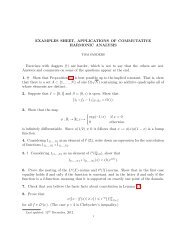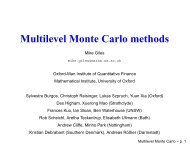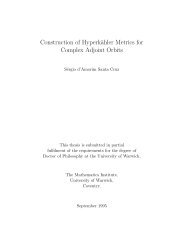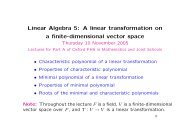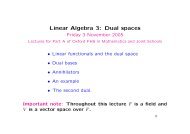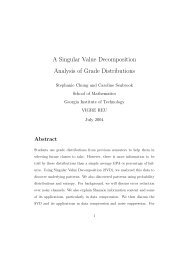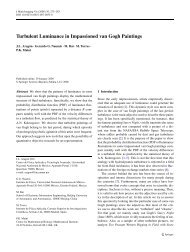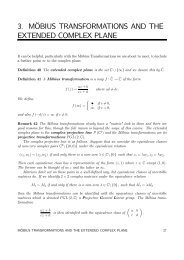Fourier Series and Partial Differential Equations Lecture Notes
Fourier Series and Partial Differential Equations Lecture Notes
Fourier Series and Partial Differential Equations Lecture Notes
You also want an ePaper? Increase the reach of your titles
YUMPU automatically turns print PDFs into web optimized ePapers that Google loves.
Chapter 5. Laplace’s equation in the plane 53<br />
Figure 20<br />
In the figure, R is the shadowed region. It has two ‘holes’ <strong>and</strong> ∂R is the union of three<br />
simple closed curves oriented as shown.<br />
5.3.1 Uniqueness for the Dirichlet problem<br />
We consider uniqueness of solutions to the Dirichlet problem, working in Cartesian coordinates.<br />
Theorem 5.4 Consider the BVP<br />
∂2T ∂x2 + ∂2T = 0 in R, T = f on ∂R, (5.50)<br />
∂y2 where f is a prescribed function <strong>and</strong> R is a bounded <strong>and</strong> connected region as in the<br />
statement of Green’s theorem. Then the BVP has at most one solution.<br />
Proof. Let S also be a solution, so that<br />
∂2S ∂x2 + ∂2S = 0 in R, S = f on ∂R. (5.51)<br />
∂y2 Then the difference W := T −S in a solution of the BVP<br />
Consider the identity<br />
W<br />
∂2W ∂x2 + ∂2W = 0 in R, W = 0 on ∂R. (5.52)<br />
∂y2 <br />
∂2W ∂x2 + ∂2W ∂y2 2 2 ∂W ∂W<br />
+ + =<br />
∂x ∂y<br />
∂<br />
<br />
W<br />
∂x<br />
∂W<br />
<br />
+<br />
∂x<br />
∂<br />
<br />
W<br />
∂y<br />
∂W<br />
<br />
. (5.53)<br />
∂y<br />
Integrate both sides over R <strong>and</strong> appeal to Laplace’s equation <strong>and</strong> Green’s theorem to find<br />
that<br />
∂W 2 <br />
2 <br />
∂W<br />
∂<br />
+ dxdy = W<br />
R ∂x ∂y<br />
R ∂x<br />
∂W<br />
<br />
+<br />
∂x<br />
∂<br />
<br />
W<br />
∂y<br />
∂W<br />
<br />
dxdy,<br />
∂y<br />
<br />
= −W ∂W ∂W<br />
dx+W<br />
∂y ∂x dy<br />
<br />
. (5.54)<br />
∂R<br />
Since W = 0 on ∂R the line integral must vanish <strong>and</strong> so<br />
∂W 2 <br />
2<br />
∂W<br />
+ dxdy = 0. (5.55)<br />
∂x ∂y<br />
R<br />
This is possible only if ∂W/∂x = 0, ∂W/∂y = 0 in R. Hence W is constant <strong>and</strong> since<br />
W = 0 on ∂R the constant can only equal zero. Hence T = S <strong>and</strong> the solution is<br />
unique.




